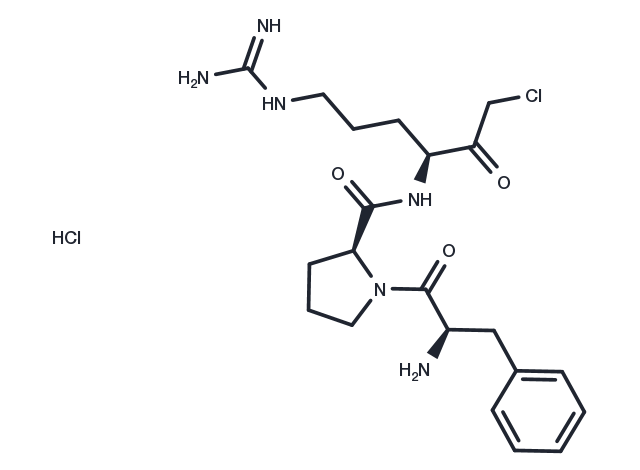Powder: -20°C for 3 years | In solvent: -80°C for 1 year


Ppack HCl is a peptide derivative that irreversibly and specifically suppresses thrombin-mediated platelet activation by binding with high affinity to the active site of thrombin (Ki: 0.24 nM). It has been utilized as an anticoagulant (100 μM) and to study thrombin-mediated fibrin deposition, angiogenesis, and proinflammatory processes.

| Pack Size | Availability | Price/USD | Quantity |
|---|---|---|---|
| 1 mg | 35 days | $ 88.00 | |
| 5 mg | 35 days | $ 380.00 | |
| 10 mg | 35 days | $ 715.00 | |
| 25 mg | 35 days | $ 1,450.00 |
| Description | Ppack HCl is a peptide derivative that irreversibly and specifically suppresses thrombin-mediated platelet activation by binding with high affinity to the active site of thrombin (Ki: 0.24 nM). It has been utilized as an anticoagulant (100 μM) and to study thrombin-mediated fibrin deposition, angiogenesis, and proinflammatory processes. |
| Synonyms | Ppack dihydrochloride, Fprmecl, dihydrochloride |
| Molecular Weight | 487.43 |
| Formula | C21H32Cl2N6O3 |
| CAS No. | 82188-90-7 |
Powder: -20°C for 3 years | In solvent: -80°C for 1 year
You can also refer to dose conversion for different animals. More
bottom
Please see Inhibitor Handling Instructions for more frequently ask questions. Topics include: how to prepare stock solutions, how to store products, and cautions on cell-based assays & animal experiments, etc.
Ppack HCl 82188-90-7 Ppack Ppack Dihydrochloride Fprmecl, Fprmecl, Dihydrochloride Ppack dihydrochloride Fprmecl, dihydrochloride inhibitor inhibit
